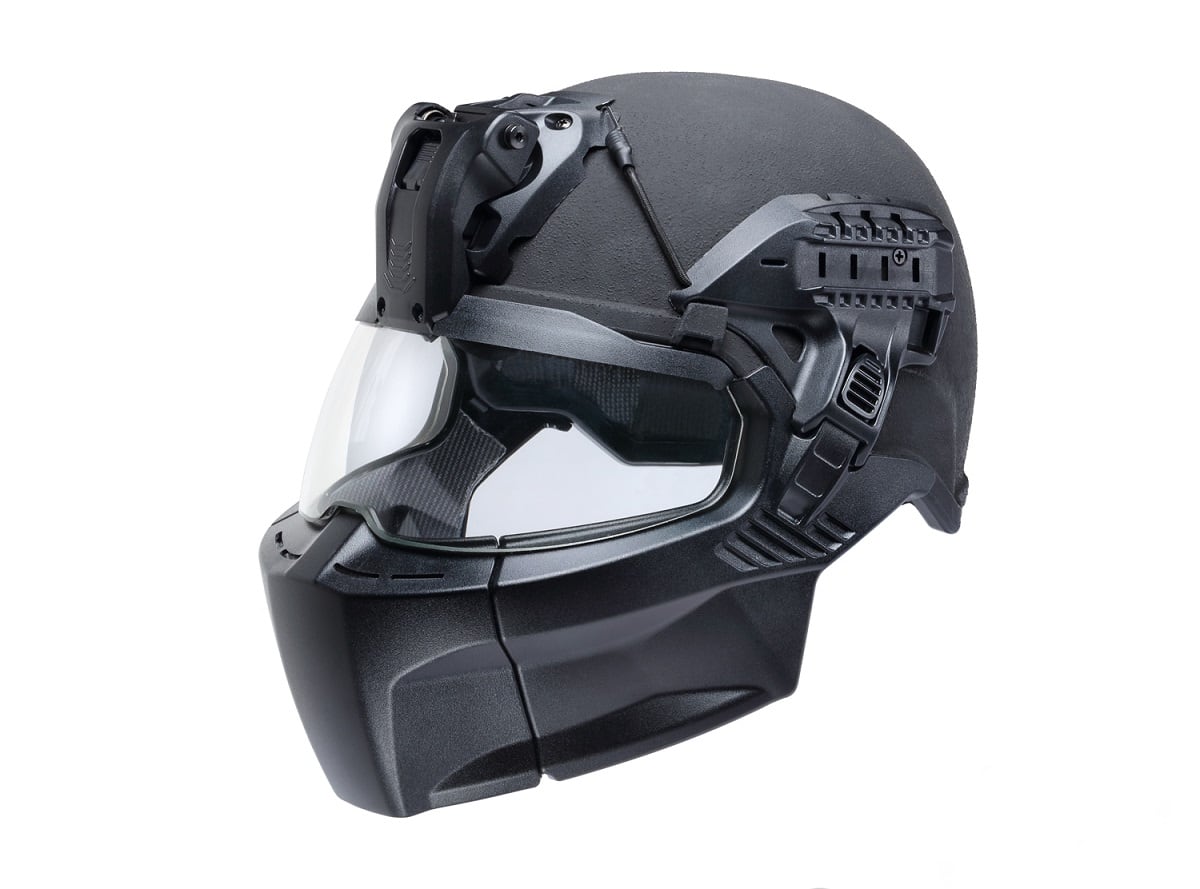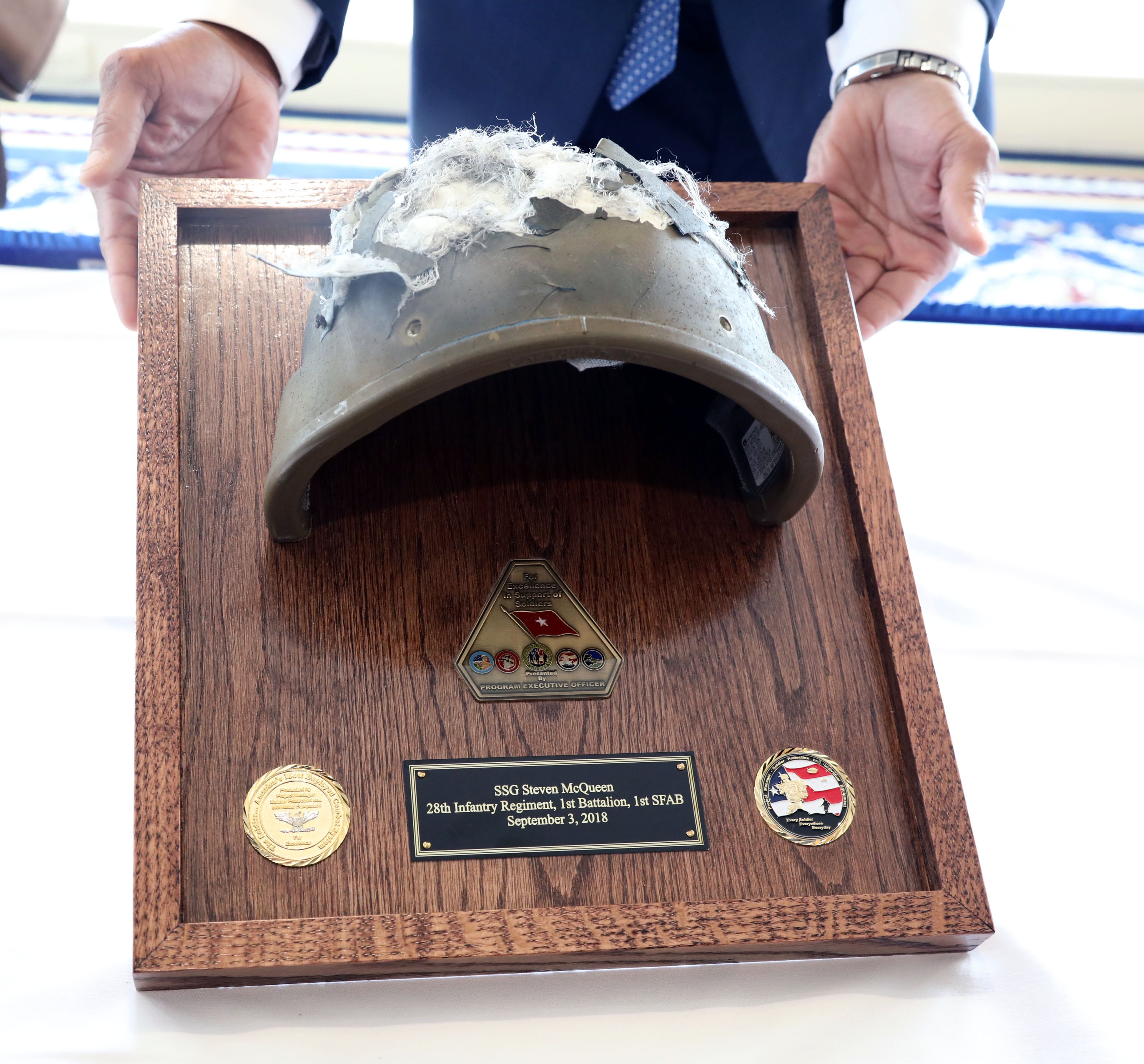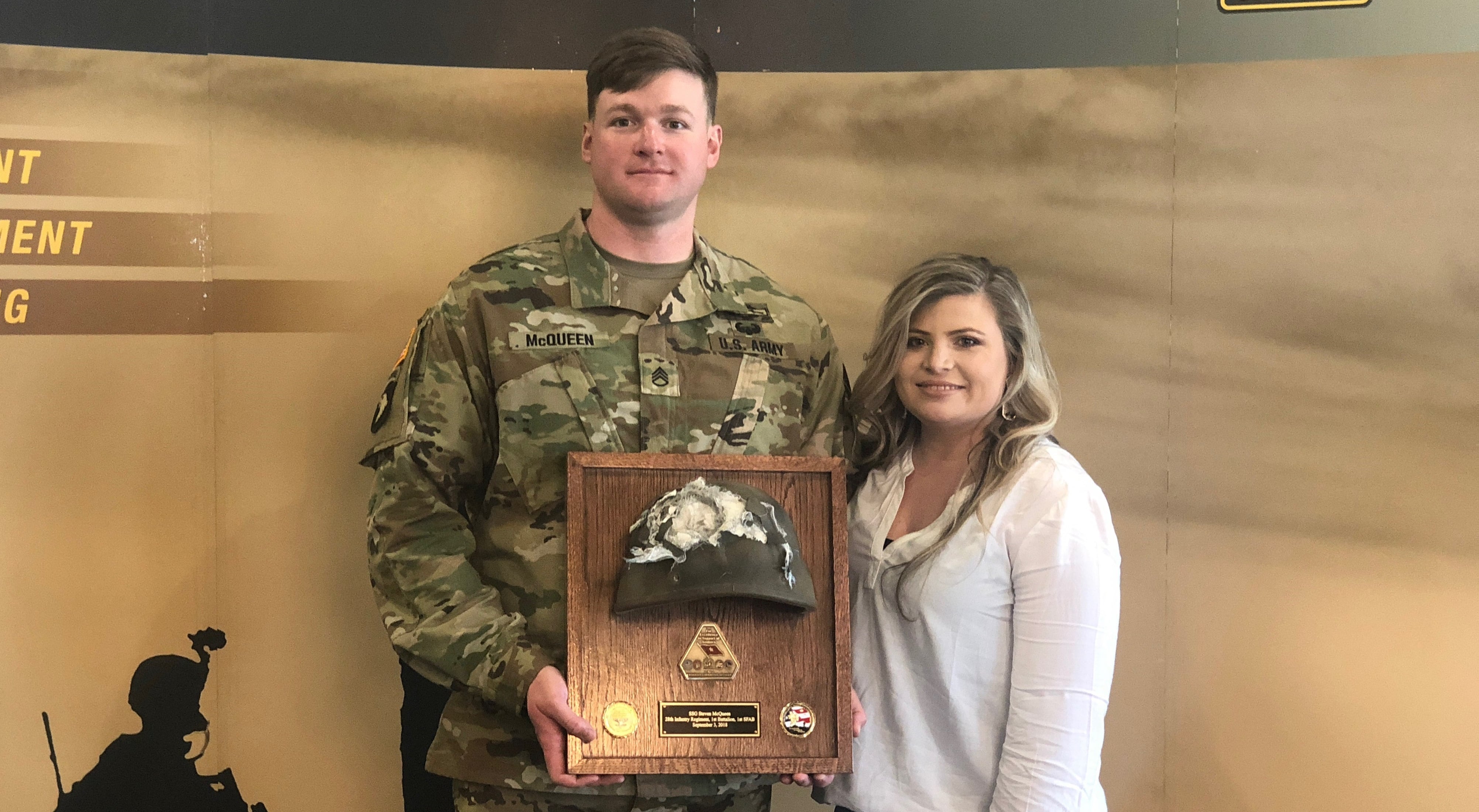FORT BELVOIR, Va. – Staff Sgt. Bryan McQueen was nearing the end of his tour in Afghanistan with the 1st Security Forces Assistance Brigade on Sept. 3, 2018. He, his fellow soldiers and nearly 50 Afghans were headed to a security meeting, as routine as any other daily assignment.
Machine gun fire erupted.
McQueen felt what he could later only describe as a horse kick to the back of his head and he fell flat to the ground, landing on his face.
But in seconds he was on his feet with a simple question.
“Did these (expletive deleted) really just shoot me in the head?” he said.
What he would learn a short time later was that two rogue Afghan police within the formation had planned an attack once the group reached a vulnerable choke point. One opened fire with a Russian PK machine gun while another aimed to take out as many soldiers as possible with his AK-47.
Afghan soldiers captured the two attackers and they now face a trial for murder and attempted murder.
The 7.62x54mmR round from the truck-mounted machine gun struck the back of McQueen’s helmet, shredding some of the materials but not penetrating the shell.
This week that same helmet, bisected and mounted on a plaque with McQueen’s name and the appropriate unit coinage, was presented to him here at a Personal Protective Equipment soldier return ceremony.
RELATED

The ceremonies are conducted through congressional authorization to return the property to soldiers who were wounded once the service branch has completed its analysis of the equipment. The returns began in 2013. The last public ceremony for such a return was held in 2016. Since the inception of the program there have been 35 PPE returns to active duty soldiers. Current efforts are underway to allow for damage PPE to be returned to wounded veterans who used the gear.
For many years defense researchers and protective equipment programs have retrieved items such as body armor and helmets damaged by enemy fire on the battlefield for forensic analysis to improve current and future gear.
Brig. Gen. Anthony Potts, head of Program Executive Office Soldier, called the ceremony a chance to see the effect of the work that equipment programs do.
“The significance, in my mind, is for us as a family, it completes the circle,” Potts said.
From the officials who decide what the requirements are for the gear to the scientists who research materials to engineers who build it and soldiers who test it before it heads to a unit, the process is a seemingly endless cycle of tinkering and adjustments to meet their mission of protecting soldiers, he said.
The helmet that McQueen wore on the day of the attack was actually acquired by PEO Soldier from the Marine Corps. The Enhanced Combat Helmet began fielding in 2014.
“There is no doubt that Staff Sgt. McQueen would not have survived that impact had he not been wearing that helmet,” said Lt. Col. Ginger Whitehead, product manager for Soldier Protective Systems.
The 1st SFAB didn’t go unscathed that September day. They lost a long-serving soldier when Cmd. Sgt. Maj. Timothy Bolyard, 42, was killed in the Logar province insider attack. Another soldier, Cpl. Joseph Maciel, 20, died in a July insider attack on the same deployment.
Though the helmet withstood the impact of a machine gun round at a distance of about 20 feet, the newest helmets the Army is now fielding are even stronger and lighter, Whitehead said.

The shooting made McQueen an instant convert.
Sitting next to a two-star general and alongside a colonel and lieutenant colonel all in charge of making gear to protect soldiers, he admitted his early skepticism.
“Before this incident, I thought the helmet … no offense guys … I thought the helmet was cumbersome and overkill,” he said. “I’ve even made the comment, and you can quote me on this, I would rather trade my (GI Bill) to wear a ball cap and a plate carrier.”
But all of that changed in the milliseconds it took for the design to save his life.
“This helmet works and I’m a living testament to it,” he said. He sees his experience and the helmet as a teaching tool to show his soldiers the value of using the gear, something he’ll ensure happens whenever they’re in a hostile environment.
The force of the round did cause a minor brain bleed but no permanent damage. He reached Kabul shortly after the incident and a doctor treating him said he should probably tell his wife what happened.
He’d been avoiding that.
And, months later, he admits with a chuckle that he probably didn’t handle it all that well.
“I sent her a text,” he said.
First he asked if she’d been contacted by anyone with the Family Readiness Group for the unit.
She said no. He said good. Then he let her know.
“I’m in the hospital in Kabul. I’m fine but I got shot in the head,” he texted.
Sitting next to him, fielding reporter questions here, Aaron McQueen also laughed.
But smiles also turned serious when she was asked about seeing the helmet and the tangible results of the close call her husband experienced.
“I knew it was bad, I knew he had been shot. I was in shock when I saw it,” she said. “If he wouldn’t have had it on then he wouldn’t have come home.”
Waiting at home then, and attending the ceremony on Monday, were his daughter, age 8, and two sons, ages 6 years and 10 months.
It’ll be a few years before McQueen thinks his children will fully understand this artifact from his tour, but it will fit prominently in his home and memory.
“It’s definitely a conversation piece,” he said.
Todd South has written about crime, courts, government and the military for multiple publications since 2004 and was named a 2014 Pulitzer finalist for a co-written project on witness intimidation. Todd is a Marine veteran of the Iraq War.
